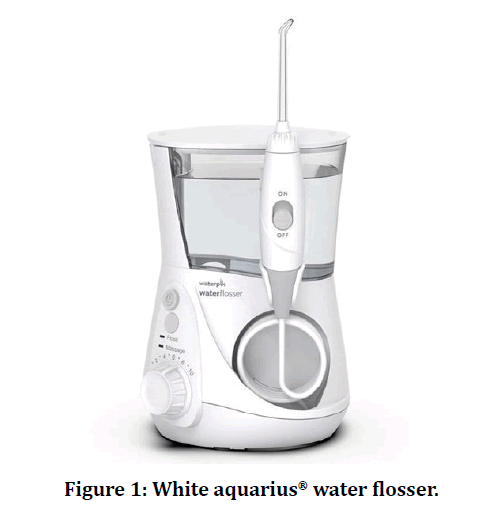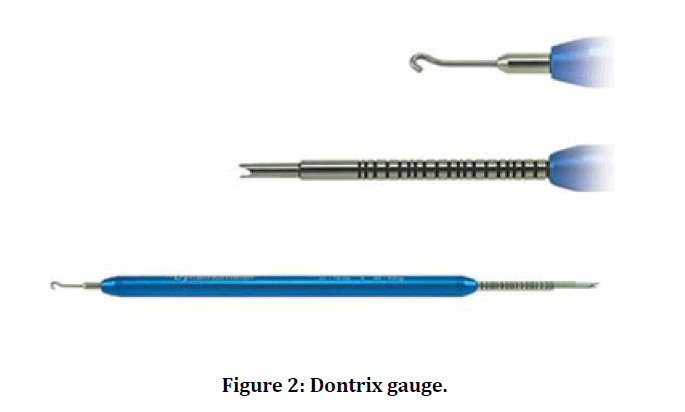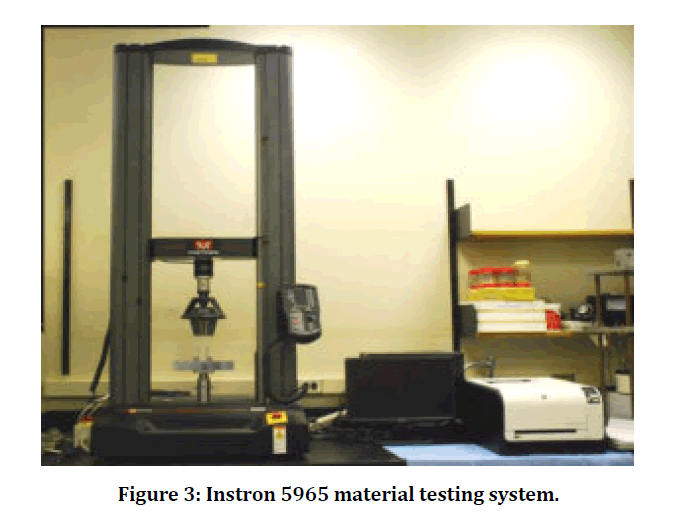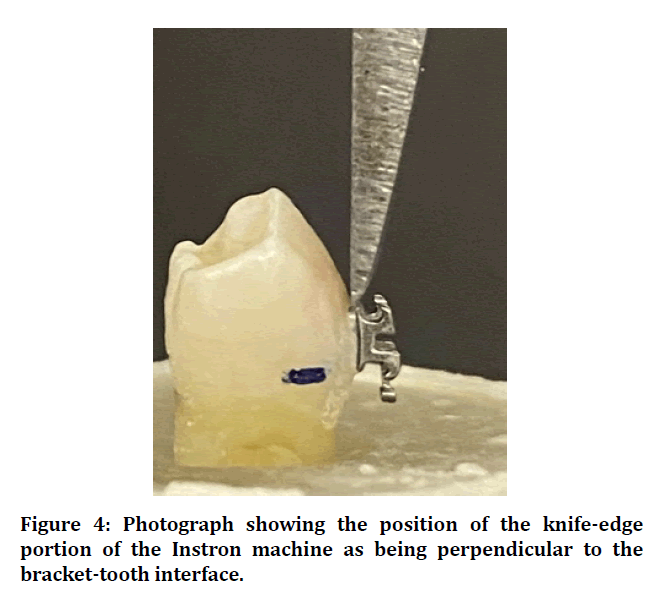Research - (2021) Volume 9, Issue 3
Effect of Water Flosser on the Shear Bond Strength of Metal Orthodontic Brackets, an in vitro Study on Human Enamel
Sarah A Alfaqeeh*, Abdullah Y Alshehri, Sultan I Alsalamh, Abdulelah A Alfehaid and Abdullah M Almuwainie
*Correspondence: Sarah A Alfaqeeh, Division of Orthodontics, Department of Pediatric Dentistry and Orthodontics College of Dentistry, King Saud University, Riyadh 11545, Kingdom of Saudi Arabia, Email:
Abstract
Background: The dental bonding agent with primer increases the strength between the tooth and orthodontic brackets by making a hydrophobic surface for the adhesive to bond to the etched tooth surface. This has controversial results in literature about the affects between bracket and teeth with use of primer bond strength. Aims: To determine the effect of water flosser on the shear bond strength (SBS) of metal orthodontic brackets. Materials and Methods: 45 sound premolars extracted for orthodontic reasons were randomly assigned into 3 groups (Gs), (G1: Control group), (G2: Teeth subjected to White Aquarius® Water Flosser device (WAWF) at quarter pressure) and (G3: Teeth subjected to WAWF at half pressure). G2 and G3 were subjected to the WAWF irrigation device for a period equivalent to 2-years of cleaning while the control group (G1) underwent no cleaning. Each group was tested using Instron® (Universal testing machine), by the aid of knife-edged rod running at a speed of 0.5 mm/min. Descriptive statistics (mean, standard deviation and range) for each group were calculated. One-way analysis of variance (ANOVA) using SPSS software version 24.0 (IBM, Chicago, IL) was used with the P-value set at 0.05.Differences in Adhesive Remnant Index (ARI) scores among groups were analyzed using the Chi-square test. Results: 15 (33.3%) teeth were located in each of the three groups. G1 had a mean shear bond strength of 23.3760 ± 9.3Mpa, G2 23.0940 ± 6.1Mpa while G3 24.3887 ± 5.2 Mpa. One-way ANOVA showed no significant differences in the bond strength measurements between the tested groups. Analysis of ARI scores showed no significant differences in the mode of bond failure among the groups (P-value 0.88). Conclusion: WAWF has no effect on the SBS of metal orthodontic brackets, thus suggesting that WAWF is safe and can be included in the oral hygiene regimes of the patients wearing this type of appliance.
Keywords
Water Flosser, Waterpik, Metal brackets, Premolars, Shear bond strength, Instron
Introduction
In the 1950s, the oral Water Irrigation Devices (WIDs) was invented by Dr. Gerald Moyer, a dentist, and John Mattingly, an engineer, in Fort Collins, Colorado, United States. In 1962, during the Dallas Dental Convention in Texas the WIDs were introduced to the dental profession [1]. Multiple studies suggested that oral WID removes bacteria from periodontal pockets and biofilm from tooth surfaces [2]. Different WIDs are now available in the market offering many different designs, features, and combinations of pulsation and pressure [3]. WIDs are a practical tool for minimizing the bleeding in gingivitis cases in a large number of patients [4]. The WIDs are broadly used for oral physiotherapy and maintaining oral hygiene in dental clinics and homes all around the world. An important area of concern in the use of WIDs is the increased probability of injury to the sulcular epithelium and underlying tissue. Several clinical cases were documented on tissue injury using WIDs as it is thought that the WIDs apply extreme pressure on the sulcular epithelium [5]. Even though it is known that the high jet impact pressures applied by the WIDs cause tissue injury, the underlying injury mechanisms are not well comprehended [6]. In orthodontics, WIDs can be used around fixed orthodontic appliances e.g. metal and toothcolored brackets but less likely with removable ones e.g. Invisalign which use is widely spread nowadays and Hawley retainers. One of the WIDs is White Aquarius® Water Flosser (WP-660) device (WAWF) (Waterpik®, Fort Collins, CO, USA) (Figure 1) which delivers a pressure range of 10 to 100 Pound per Square Inch(PSI) and a flow rate of 384 ml per minute. WAWF comes with different tips and a water reservoir. One of the tips is used for cleaning around orthodontic brackets by gently passing the tip along the gumline, between the teeth and all-around orthodontic brackets [7]. Water flosser devices (WFDs) nowadays are becoming widely used as interdental cleaning aid on a daily basis, and some of the users are undergoing orthodontic treatment, but there is a lack of knowledge in the literature about the effect of the WF device on the bonded metal orthodontic brackets.
Figure 1:White aquarius® water flosser.
Fixed orthodontic appliances are favored by most clinicians for treatment as the reliance on the cooperation of the patient is wearing the removable appliance is no longer a concern [8]. Metal Orthodontic brackets are usually attached to the tooth by light-activated resin, a single component material that is easier to manipulate when compared to other types of cements [9]. The Shear Bond Strength (SBS) of the metallic orthodontic brackets has been reported to be affected by several other factors. Several studies have made contradictory interpretations about the effect of the bleaching on orthodontic brackets bonding [10,11]. Rebonded brackets, interestingly, were reported to have higher SBS than new brackets [12]. Lastly, in a study by Leódido et al. [13], teeth that were pre-treated with fluoride solutions showed a statistically significant reduction in their SBS when compared to controls that were not pre-treated with fluoride.
Due to the lack of knowledge in the literature about the effect of WFDs on the bonded orthodontic brackets, and consequentially, the orthodontic treatment success; this study aims to evaluate the effect of WFDs on the SBS of metal orthodontic brackets.
Materials and Methods
This experimental in-vitro study was conducted in the physical research laboratory at King Saud Dental University Hospital. The protocol for this study was approved by the Institutional Review Board (IRB) of King Saud University (E-19-4199). A sample of 45 sound premolars extracted for orthodontic reasons, was randomly assigned into 3 groups, group 1 (G1): control group, G2: Teeth subjected to WAWF at quarter pressure and G3: teeth subjected to WAWF at half pressure. The inclusion criteria were restricted to that all teeth should have an intact crown, no attrition, free from hypoplastic areas, cracks, obvious irregularities, teeth decay, fractures [12], nonbleached teeth [14] and no pre-treatment with fluoride solutions [13]. Teeth were stored in distilled water at room temperature, not more than 30 days before using them in the study. The enamel surfaces of the teeth were polished with a polishing cup and pumice for 10 seconds on low-speed handpiece [12]. Teeth were mounted on open-ended cylinders which were cut out of polyvinyl chloride (PVC) pipe. Each PVC cylinder was filled with orthodontic resin into which a premolar tooth is mounted in a parallel position to the Universal testing machine (Instron® 5965 material system, Grove City, PA, USA) at brackettooth structure interface. The metal orthodontic brackets (3M, Unitek™ Miniature Twin, St. Paul, MN, United States) were bonded to the teeth with adhesive resin (3M, Transbond ™ XT Light Cure Adhesive, St. Paul, MN, United States) after being acid etched with 35% phosphoric acid solution (Ultra-Etch™, South Jordan, UT, United States) for 15 seconds and careful rinsing [15]. It was air-dried until a chalky appearance appears on the treated tooth, for those teeth that did not show a chalky appearance, the procedure was repeated [16]. A bonding agent (Ivoclar, Tetric® N-Bond, Shann, Liechtenstein) was applied on the etched enamel surface with a micro-brush and followed by gentle air application then lightcured for 20 seconds. A plastic instrument was used to apply adhesive resin over the bracket mesh base. A bracket placing plier (3M, Unitek™, St. Paul, MN, United States) was used to seat and position the bracket in the middle third of the buccal enamel surface. The brackets were fixed firmly on the tooth surface with the Dontrixgauge (Sino-Dental®, Hangzhou, China) (Figure 2), an instrument that is designed to accurately measure the forces used in orthodontic bracket application (300 grams). The excess material was removed. From a consistent distance of 6mm, the orthodontic bracket was light-cured for 20 seconds from the buccal side of the tooth and 20 seconds from the lingual side, for a total time of 40 seconds according to the manufacturer’s instruction. After bonding the brackets, all samples were stored in distilled water at room temperature, and then the teeth from (G2,G3) were subjected to a WAWF irrigation device for the equivalent of 2-years cleaning period while the control group (G1) underwent no cleaning. Each group was tested using the Universal testing machine (Figure 3), with the aid of a knife-edged rod running at a speed of 0.5 mm/ min strength perpendicular to the brackettooth interface of each specimen [17] (Figure 4); bracket failure was recorded electronically and calculated in megapascal (MPa) using the machine’s software. The adhesive remnant index (ARI) score post Instron testing was performed under a microscope (Hirox digital microscope KH-7700) at 10X magnification to determine the location of bond failure. Oz et al. [18] ARI score was as followed:
Figure 2: Dontrix gauge.
Figure 3: Instron 5965 material testing system.
Figure 4: Photograph showing the position of the knife-edge portion of the Instron machine as being perpendicular to the bracket-tooth interface.
ARI score:
0=no adhesive remaining on enamel
1=less than or equal to 50% adhesive remaining on enamel
2=more than 50% but less than 100% adhesive remaining on enamel
3=all adhesive remaining on enamel
Results were documented and analyzed.
Statistical analyses
Descriptive statistics (mean, standard deviation and range) for each group were calculated. Normality was satisfied, one-way analysis of variance (ANOVA) was used to analyze differences in SBS among the three groups. G1, G2 and G3. Differences in ARI scores among different groups were analyzed using Chi- Square test. Level of significance was set at 0.05 (P-value). Statistical Package for the Social Sciences (SPSS) software version 24.0 (IBM, Chicago, IL) was used.
Results
There were 45 teeth with 15 (33.3%) in each of the three groups. G1 had mean SBS of 23.3760 ± 9.3 MPa, G2 23.0940 ± 6.1 MPa and G3 24.3887 ± 5.2 MPa (Figure 5). One-way ANOVA showed no significant differences in bond strength measurements between experimental groups (Table 1).
Figure 5: The mean SBS of the three groups is portrayed in this graph.
ARI scores show that the majority of G1 had 50% or less remaining adhesive on the tooth surface, similarly for G2 and G3 (Figure 6). Chi-square test showed no significant differences in the mode of bond failure among the three groups (Table 2).
Figure 6: Graph representing the distribution of the remaining adhesive in the tested groups.
Results
Discussion
Awareness of the importance of oral hygiene (OH) has increased in recent years as well as the development of devices for this purpose. One of the recent OH devices is WAWF. This in vitro study investigated the effect of WAWF on the SBS of metal orthodontic brackets for a simulated period of two years. Orthodontic brackets were placed on extracted teeth then subjected to WAWF under conditions typical of clinical use to simulate in vivo conditions closely. WAWF exerts a pressure of 10-100 PSI, this might affect the bond strength of orthodontic brackets, and numerous tests are available to measure the bond strength such as shear, tension, and torsion. The most common testing method for bracket bond strength is the shearing test. Occlusal forces and mastication creates the shearing force, bracket failure occurs when the shearing force is greater than bond strength. Acceptable SBS clinically has been determined to range from 5.9-7.8 MPa [19]. In this study, SBS values generated by all groups were above the clinical requirement for acceptable bonding. The SBS mean of the control group G1 was 184 Newton whereas it ranges from 180.85 - 188.55 N for experimental groups. Our study found that the mean SBS in control group G1 was 23.376 MPa while that of the experimental groups (G2, G3) were 23.094 and 24.39 MPa, respectively. The difference in the SBS mean values between all three groups was statistically insignificant. These findings are in accordance with a previous study that compared SBS between the powered toothbrush and manual tooth brush which had insignificant results between the two groups (20). Unlike another study done by Leódido et al. [13], that measured the SBS of metal orthodontic brackets bonded to fluoridated teeth and non-fluoridated teeth found a significant difference among their groups with reduction of SBS in fluoridated teeth compared to non-fluoridated teeth. The current study conducted by subjecting G2 and G3 to a WAWF device for 52 minutes which is equivalent to 2-years cleaning (120 seconds per cleaning for 28 teeth), therefore each tooth=4.2 seconds per day; Thus, for two years interval, it is equal to 3128 seconds=52 minutes [20] and the control group (G1) underwent no cleaning. The experiment was carried by one investigator for G2 and G3. The application technique used for WAWF was by applying WFDs on each side of the bracket: mesial, distal, incisal and gingival each side for 13 minutes resulting in a total of 52 minutes. The pressure of WAWF can be controlled by a pressure control dial switch which has different levels of pressure ranging from 0 to 10. The quarter pressure group was set at 2.5 (25 PSI) and the half pressure group was set at 5 (50 PSI).
In our study, the ARI scores showed no significant differences between all groups. After debonding of the bracket base from tooth surface examination indicates that resin might adhere either to the tooth surface or to the bracket base. Adherence to the tooth indicates that the enamel surface remained intact, whereas adherence to the bracket base is suggestive of surface enamel removal during the debonding process [21]. In this study, most bond failures after analyzing ARI scores occurred at the enamel-adhesive interface. The limitations of our study are that we were incapable of using the Dontrix gauge, which accurately measures the forces used for placement of the bracket, as it led to sliding of the bracket from its position. Secondly, the inability to use WAWF on maximum pressure, as it was unable to withstand 52 minutes of cleaning under maximum pressure, resulting in two devices shutting down after our first sample, and from personal experience, usage of maximum pressure in the oral cavity is harsh to soft tissue and bothering during usage. The comfortable and effective pressure level was from 2 to 5.5.
Conclusion
Within the limitations of this study, we can recommend using WAWF from low to half pressure as a daily routine oral hygiene measures throughout orthodontic treatment as WAWF does not adversely affect the bonding strength of the orthodontic brackets, thus suggesting that WAWF is safe to use for orthodontic patients.
Decleration of Interests
The authors report no declarations of interest.
Acknowledgements
We would like to express our very great appreciation to all people who were involved in this research. First of all, our appreciation goes to Undergraduate Students Research Support Program (USRSP) at King Saud University (grant number: URSP – 5- 20- 05) for funding this research. Secondly, our gratitude goes to Dr. Nasr Almaflehi for his assistance with the statistics. Lastly, we would like to express our deep gratitude to Mr.Egnacio Tuazon who helped us a lot in laboratory work. Our completion of this project could not have been accomplished without your support, thank you all.
References
- Ciancio SG. The dental water jet: A product ahead of its time, Compend Contin Educ Dent 2009; 30:7–13.
- Hurst JE, Madonia JV. The effect of an oral irrigating device on the oral hygiene of orthodontic patients, J Am Dent Assoc 1970; 81:678–682.
- Lyle DM, Relevance of the water flosser: 50 years of data, Compend Contin Educ Dent 2012; 33:278–280.
- Flemmig TF, Epp B, Funkenhauser Z, et al. Adjunctive supragingival irrigation with acetylsalicyclic acid in periodontal supportive therapy. J Clin Periodontol 1995; 22:427–433.
- Clark JW, Jurand JG, Miller CD. Effectiveness of conventionally practiced oral hygiene in the prevention of dental-deposit-mediated disease. In: Surf Chem Dent Integuments Thomas CC, Publisher Springfield, Illinois, 1973.
- Reddy NP, Kesavan SK. Mechanisms of tissue damage resulting from the use of oral water irrigation devices. Med Hypotheses 1985; 18:417–423.
- Waterpik®, Water Pik product manual, Waterpik® Complete care models CC-01 CC-02. 2018.
- Millett DT, Glenny A, Mattick RCR, et al. Adhesives for fixed orthodontic bands. Cochrane Database Syst Rev 2016; 10.
- Ewoldsen N, Demke RS. A review of orthodontic cements and adhesives. Am J Orthod Dentofac Orthop 2001; 120:45–48.
- Bishara SE, Sulieman AH, Olson M. Effect of enamel bleaching on the bonding strength of orthodontic brackets. Am J Orthod Dentofac Orthop 1993; 104:444–447.
- Miles PG, Pontier JP, Bahiraei D. Close, The effect of carbamide peroxide bleach on the tensile bond strength of ceramic brackets: An in vitro study. Am J Orthod Dentofac Orthop 1994; 106:371–375.
- Salama F, Alrejaye H, Aldosari M, et al. Shear bond strength of new and rebonded orthodontic brackets to the enamel surfaces. J Orthod Sci 2018; 7.
- Leódido G, Fernandes HO, Tonetto MR, et al. Effect of fluoride solutions on the shear bond strength of orthodontic brackets. Braz Dent J 2012; 23:698–702.
- Amuk NG, Baysal A, Üstün Y, et al. The effects of different desensitizer agents on shear bond strength of orthodontic brackets after home bleaching: An in vitro study Eur Oral Res 2018; 52:69.
- Pham D, Bollu P, Chaudhry K, et al. Comparative evaluation of orthodontic bracket base shapes on shear bond strength and adhesive remnant index: An in vitro study. J Clin Exp Dent 2017; 9:e848.
- Alrafaa AA, Bilal R, Alshahrani I. Does the antioxidant treatment affect the shear bond strength of orthodontic brackets: An in vitro study. J Pak Med Assoc 2019; 69:82–86.
- Alshahrani I, Abdelaziz K, Asiry MA, et al. Effects of different stain removal protocols on bonding orthodontic brackets to enamel. J Contemp Dent Pract 2018; 19:762–767.
- Oz AA, Yazicioglu S, Arici N, et al. Assessment of the confidence of the adhesive remnant index score with different methods. Turkish J Orthod 2014; 26.
- Reynolds IR. A review of direct orthodontic bonding Br J Orthod 1975; 2:171–178.
- Garcia-Godoy F, de Jager M. Effect of manual and powered toothbrushes on orthodontic bracket bond strength. Am J Dent 2007; 20:90.
- MacColl GA, Rossouw PE, Titley KC, et al. The relationship between bond strength and orthodontic bracket base surface area with conventional and microetched foil-mesh bases. Am J Orthod Dentofac Orthop 1998; 113:276–281.
Author Info
Sarah A Alfaqeeh*, Abdullah Y Alshehri, Sultan I Alsalamh, Abdulelah A Alfehaid and Abdullah M Almuwainie
Division of Orthodontics, Department of Pediatric Dentistry and Orthodontics College of Dentistry, King Saud University, Riyadh 11545, Kingdom of Saudi ArabiaCitation: Sarah A Alfaqeeh, Abdullah Y Alshehri, Sultan I Alsalamh, Abdulelah A Alfehaid, Abdullah M Almuwainie, Effect of Water Flosser on the Shear Bond Strength of Metal Orthodontic Brackets, an in vitro Study on Human Enamel, J Res Med Dent Sci, 2021, 9 (3): 11-16.
Received: 20-Jan-2021 Accepted: 09-Mar-2021 Published: 16-Mar-2021





